Endocrinology is one of the older scientific pursuits, imbibing it with an undeserved veneer of research stagnation: surely all major endocrine findings have been made, haven’t they?
However, this could not be further from the truth, as our recent Society for Endocrinology Themed Scientific Meeting highlighted. Here, we explored how sulfation and desulfation – fundamental, evolutionary conserved pathways – regulate and control steroid hormone action.
BACKGROUND
Steroid hormones circulate mainly in their sulfated form, in particular oestrogens and dehydroepiandrosterone (DHEA). They require desulfation by steroid sulfatase to become active. Conversely, many hormones can be sulfated by sulfotransferases, making them (in general) inactive, with increased water solubility to expedite transport in the blood and subsequent excretion. Traditionally, sulfation was held to act purely as a means by which hormones were removed from the circulation.
‘On the back of this grant, we were able to secure further funds through an MRC Proximity to Discovery Grant.’
However, with our greater understanding of intracrine metabolism, evidence now suggests that sulfation/desulfation pathways play a major role in regulating steroid action locally. Targeting this local formation of active hormones may prove fruitful for the treatment of numerous diseases, including metabolic disease, endometriosis and steroid-dependent cancers.
Furthermore, due to recent technological advances, particularly in the field of mass spectrometry, our abilities to measure sulfated and non-sulfated hormones have become much more sensitive. Thus, there is considerable interest in utilising these new methods to fully appreciate how active hormone concentrations are regulated at the cellular level.
SPRINGBOARD TO SUCCESS

Delegates at the Birmingham meeting. ©Nick Robinson
Our recent comprehensive review on steroid sulfation and desulfation1 turned out to be a springboard from which to build our growing appreciation of sulfation biology. The next logical way forward was to organise a meeting primarily focused on identifying potential pathways within sulfation and desulfation that are ripe for targeting to treat disease.
Receiving a much sought-after Society for Endocrinology Themed Scientific Meeting Grant enabled us to bring together the world leaders in sulfation and desulfation at the University of Birmingham. The application process was very straightforward and allowed for flexibility regarding the timing of our meeting.
Furthermore, on the back of this grant, we were able to secure further funds through an MRC Proximity to Discovery Grant, designed to facilitate key interactions with industry leaders. Subsequently, we had representatives at the meeting from a range of partners, which allowed interaction between academia and industry, leading to potential future collaborations.
‘Very few professional scientific societies offer such a significant amount of money (up to £10,000) with which to organise a scientific meeting.’
BREADTH AND DIVERSITY
The event we organised involved many world-leading researchers, challenging numerous aspects of sulfation and desulfation research. Despite having a rather specific title, our meeting actually encompassed a rather broad scope, providing many talking points, which augmented collaboration throughout the conference.
Talks covered such diverse topics as targeting steroid desulfation in breast cancer, measuring disulfates by mass spectrometry, sulfated androgens in women’s health, and even hormone sulfates in the porcine testicular compartment! A number of novel ideas focused on targeting desulfation were also explored, highlighting the translational potential to treat disease that is inherent in these pathways.
In summary, we were extremely happy with how the Society for Endocrinology Themed Scientific Meeting Grant helped us organise this conference. Very few professional scientific societies offer such a significant amount of money (up to £10,000) with which to organise a scientific meeting. Bolstered by this good experience, we will be looking forward to (organising) further meetings focused on sulfation and desulfation pathways in the future.
Paul A Foster & Jonathan Wolf Mueller, Institute of Metabolism and Systems Research, University of Birmingham
REFERENCE
- Mueller JW et al. 2015 Endocrine Reviews 36 526–563.
The Society’s Themed Scientific Meeting Grant provides up to £10,000 to support the best new science by funding short, focused scientific meetings. The next application deadline is 31 May 2018. You can find more information in the grants section of our website.






